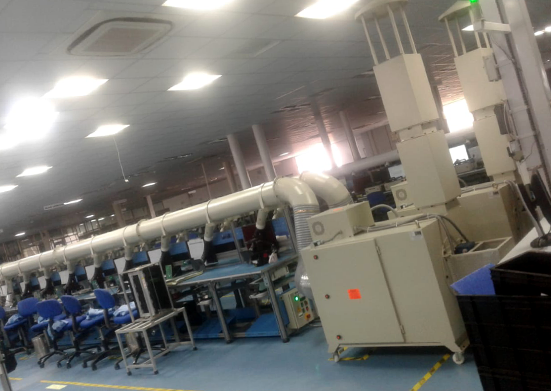The special purpose machine has two adjacent component welding stations. The welding fume generation area is open, without any enclosure. The welding process takes place only at one station at a time. The jobs are loaded manually by a skilled operator. During welding fumes are generated which are to be captured and the pollutants in the fumes are to be filtered effectively.
Our Fumekiller®, electrostatic filter model FK3600/3hp was suggested to be mounted on an MS Grouted pipe stand of about 5ft height positioned just behind the welding machine. Two MS painted suction hoods were placed just above the two welding stations at a convenient height after studying operational comfort as well as optimum fume suction distance. The suction hoods were connected to a common MS ducting fitted to the Fumekiller® equipment and supported from the fume extractor.
The fume extractor was switched on during the welding process. The welding fumes generated at the two component welding stations were captured by the fume extractor through the 2nos of suction hoods placed above the welding spots effectively. The fume extractor should be operational as long as the welding process is being carried out.
The welding fumes consisting of various pollutants such as manganese, chromium, nickel, and other potentially harmful elements, enter the electrostatic filter (Fumekiller®) through the air stream. The ionisation section of the filter charges all particles 0.01 micron and larger in the air stream. The air enters the collection section where the pollutants adhere to the collection plates. Pollutants as small as 0.01 micron and larger are collected. The clean air is let out at the exhaust port of the fume extractor.
It was found that for a single shift, the filters collected the pollutants for about 3 weeks before getting choked. The cleaning cycle for the filters was established at 3 weeks. Just before getting fully choked, the filter module as well as the prefilters and postfilters are removed and cleaned using pressure water pump at about 110bar pressure. The filters are dried using a compressed air jet and repositioned inside the fume extractor. Adequate training was given to the maintenance technicians to handle the equipment. All safety features were explained and demonstrated.
Visit us: https://www.powertechindia.com





